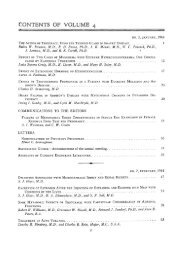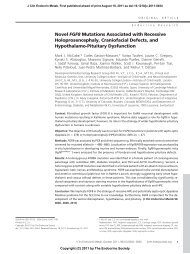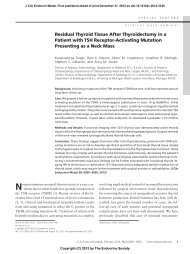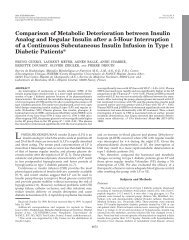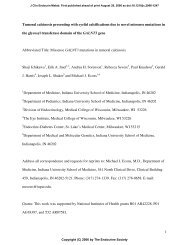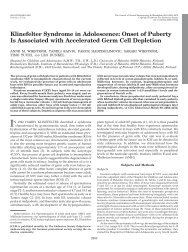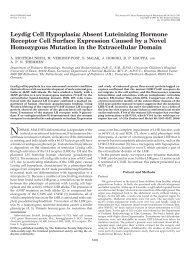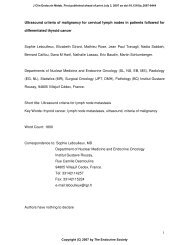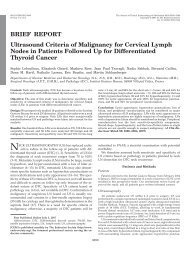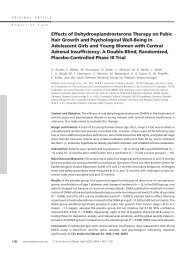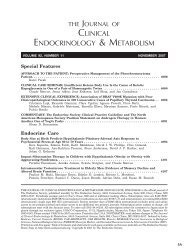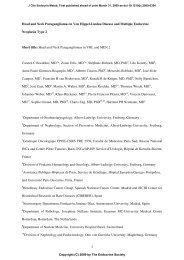The Effects Of Exercise-Induced Weight Loss On - The Journal of ...
The Effects Of Exercise-Induced Weight Loss On - The Journal of ...
The Effects Of Exercise-Induced Weight Loss On - The Journal of ...
Create successful ePaper yourself
Turn your PDF publications into a flip-book with our unique Google optimized e-Paper software.
1612 Martins et al. <strong>Exercise</strong> and Appetite Control J Clin Endocrinol Metab, April 2010, 95(4):1609–1616<br />
TABLE 1. Anthropometry, body composition, and<br />
fitness levels at baseline and the end <strong>of</strong> the exercise<br />
intervention (n � 15)<br />
Baseline End<br />
<strong>Weight</strong> (kg) 96.1 � 12.0 b<br />
92.6 � 11.7 b<br />
BMI (kg/m 2 ) 31.3 � 2.3 b<br />
30.1 � 2.3 b<br />
Body fat (%) 35.3 � 5.6 b<br />
33.5 � 5.9 b<br />
Total fat mass (kg) 34.1 � 4.9 b<br />
31.2 � 5.0 b<br />
Total FFM (kg) 60.8 � 11.3 60.2 � 11.1<br />
RMR (kcal/d) 1830.7 � 317.3 a<br />
1741.7 � 324.9 a<br />
Fitness level VO2max (ml/kg/min)<br />
32.9 � 6.6 b<br />
37.7 � 5.9 b<br />
Results are expressed as means � SD.<br />
Means sharing the same symbol denote significant differences<br />
between baseline and end: a P � 0.05; b P � 0.0001.<br />
Anthropometry, body composition, RMR, fitness<br />
levels, and eating behavior<br />
Changes in anthropometry, body composition, RMR,<br />
and fitness levels in the 15 participants who completed the<br />
study are shown in Table 1. <strong>The</strong>re was a significant reduction<br />
in body weight, BMI, percentage body fat, total<br />
fat mass, and RMR and a significant increase in VO 2max<br />
after the 12 wk <strong>of</strong> exercise (t � 9.46, df � 14, P � 0.0001;<br />
t � 9.11, df � 14, P � 0.0001; t � 4.65, df � 14, P �<br />
0.0001; t � 7.981, df � 14, P � 0.0001; t � 2.297, df �<br />
14, P � 0.05; and t ��5.68, df � 14; P � 0.0001,<br />
respectively), but no change in total fat-free mass (FFM)<br />
(t � 1.344; df � 14; P � 0.2).<br />
Habitual energy and macronutrient intake<br />
<strong>The</strong>re were no significant changes in energy (2252 �<br />
569 vs. 2228 � 667 kcal; t � 0.17; df � 14; P � 0.05 or<br />
macronutrient intake, assessed by the 3-d food diaries,<br />
with the exercise intervention.<br />
Plasma metabolites and hormones and insulin<br />
sensitivity<br />
Fasting plasma levels and insulin sensitivity<br />
<strong>On</strong>e outlier was removed due to abnormally high levels<br />
<strong>of</strong> AG plasma levels at baseline [214.5 pmol/liter for fasting<br />
and 44,655 pmol/liter�min for postprandial total AUC<br />
(3.4 and 3.5 SD values away from the mean, respectively)].<br />
<strong>The</strong> fasting plasma levels <strong>of</strong> the metabolites and hormones<br />
measured and insulin sensitivity, before and after the<br />
12-wk exercise intervention, are displayed in Table 2.<br />
<strong>The</strong> exercise intervention resulted in a significant reduction<br />
in insulin and a significant increase in AG fasting<br />
plasma levels (t � 3.49, df � 14, P � 0.004; t ��2960,<br />
df � 13, P � 0.011, respectively), but no significant<br />
changes in glucose, TG, GLP-1, or PYY fasting plasma<br />
levels. <strong>The</strong> exercise intervention resulted also in a signif-<br />
TABLE 2. Fasting plasma levels <strong>of</strong> metabolites and<br />
hormones and insulin sensitivity at baseline and the end<br />
<strong>of</strong> the exercise intervention (n � 15)<br />
Baseline End<br />
Glucose (mmol/liter) 5.2 � 0.4 5.3 � 0.3<br />
Insulin (pmol/liter) 109.0 � 68.2 b<br />
62.8 � 24.8 b<br />
TG (pmol/liter) 616.6 � 271 704.7 � 303.7<br />
AG (pmol/liter) 37.2 � 18.2 a<br />
51.7 � 26.0 a<br />
GLP-1 (pmol/liter) 12.8 � 6.1 11.7 � 2.3<br />
PYY (pmol/liter) 10.6 � 5.5 10.3 � 4.8<br />
S I (%) 69.5 � 50.4 c<br />
99.4 � 51.8 c<br />
Results are expressed as mean � SD. SI (%), Fasting insulin sensitivity as<br />
a percentage <strong>of</strong> a normal reference population.<br />
Means sharing the same symbol denote significant differences<br />
between baseline and end: a P � 0.05; b P � 0.01; c P � 0.0001.<br />
icant increase in fasting insulin sensitivity (t ��5.37; df �<br />
13; P � 0.0001).<br />
Postprandial plasma levels<br />
Glucose and insulin. A significant main effect <strong>of</strong> time<br />
[F(1.720, 17.197) � 9.951; P � 0.0001], but no effect <strong>of</strong><br />
exercise or interaction, was observed on glucose plasma levels,<br />
which increased from breakfast until t � 30 min and<br />
decreased afterward (data not shown). A significant effect <strong>of</strong><br />
time [F(1.895, 23.819) � 25.53; P � 0.0001] and exercise<br />
(P � 0.05), but no interaction, was observed in insulin<br />
plasma levels (Fig. 1). Insulin plasma levels increased from<br />
breakfast until t � 45 min and decreased afterward and were<br />
significantly lower after the exercise intervention.<br />
Appetite-related hormones. A significant main effect <strong>of</strong><br />
time [F(7,91) � 21.565; P � 0.0001], but no effect <strong>of</strong><br />
exercise or interaction, was observed on TG plasma levels,<br />
which decreased from breakfast until t � 90 min and increased<br />
progressively afterward (Fig. 2). <strong>The</strong> amplitude <strong>of</strong><br />
change in TG plasma levels (peak � nadir) increased, on<br />
average, 30% with the exercise intervention (204 � 123<br />
vs. 261 � 151 pmol/liter), but this was not significant (t �<br />
�1.519; df � 14; P � 0.151).<br />
FIG. 1. Insulin plasma levels (pmol/liter) over time after breakfast,<br />
before (�) and after a 12-wk exercise intervention (�). Values<br />
represent means � SEM for 15 subjects. Repeated measures ANOVA<br />
showed a significant effect <strong>of</strong> time (P � 0.0001) and exercise (P �<br />
0.05), but no interactions.



